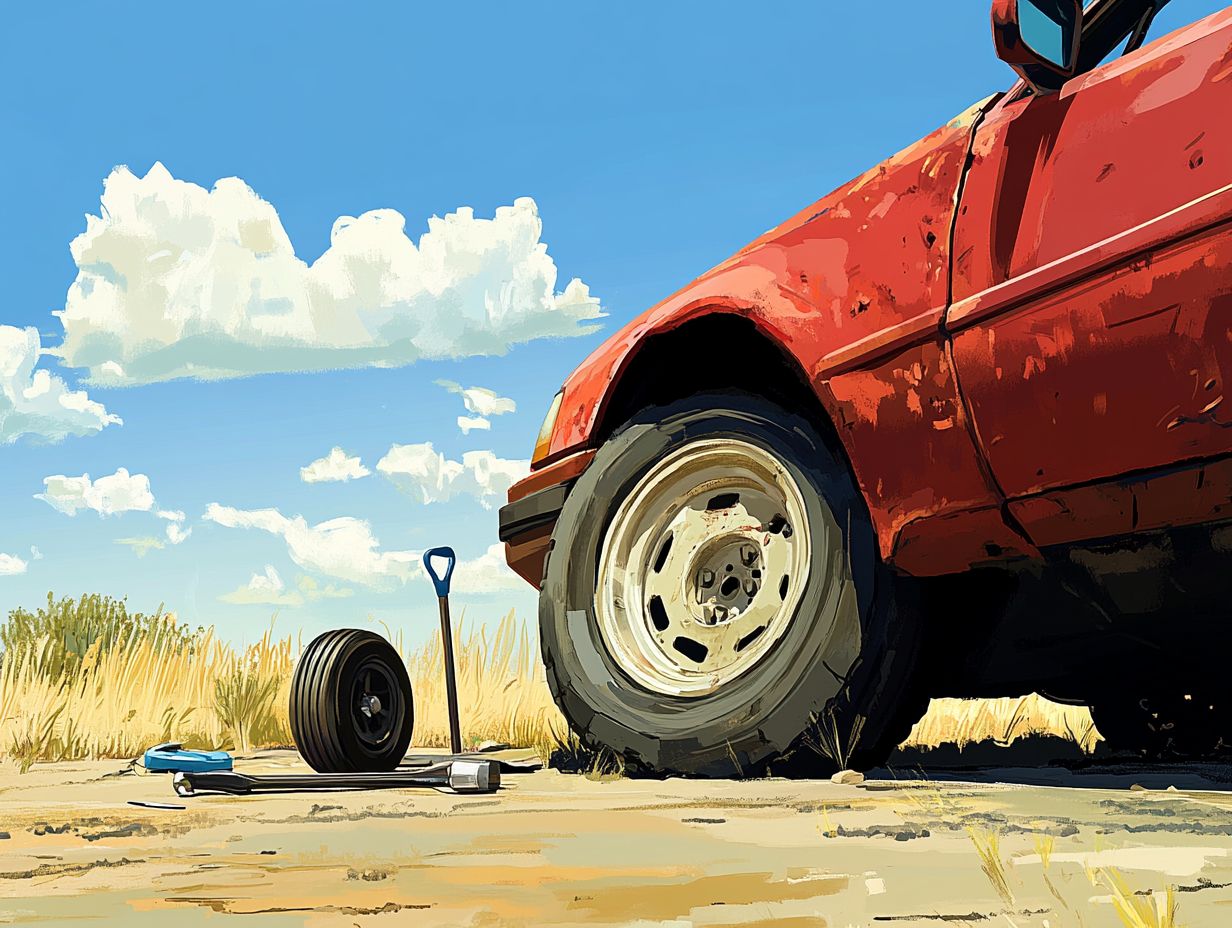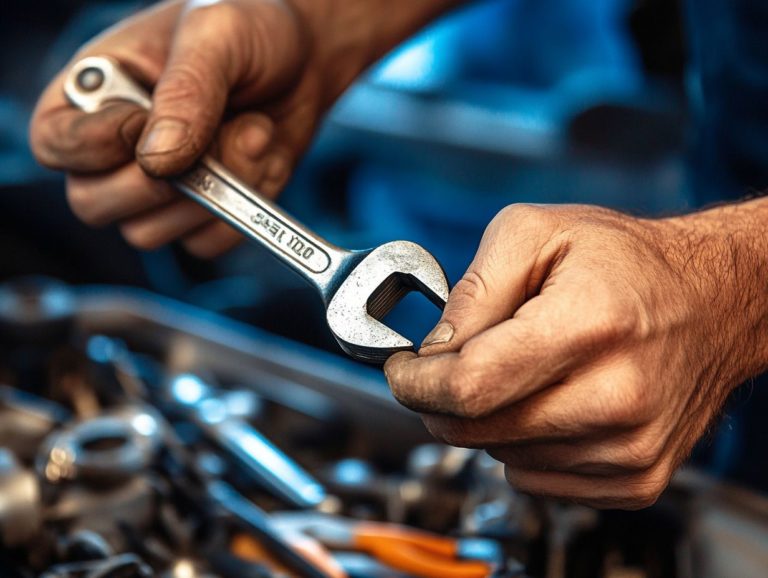How to Deal with Common Tire Blowouts
Tire blowouts can be alarming and dangerous. Understanding their causes and recognizing the warning signs allows you to take proactive steps to prevent them.
Implementing essential strategies for tire maintenance helps you avoid unexpected blowouts that catch you off guard. This guide details how to handle a blowout and offers valuable tips for emergency preparedness.
It is crucial to distinguish between front and rear tire blowouts for your safety on the road. Equip yourself with the knowledge to keep your tires in peak condition and manage emergencies with confidence!
Contents
Key Takeaways:

Understanding Tire Blowouts
Grasping the intricacies of tire blowouts is essential for every driver. They can put your safety at risk and potentially lead to catastrophic accidents.
A tire blowout occurs when a tire unexpectedly fails, influenced by factors like inadequate tire maintenance, improper tire pressure, or treacherous road hazards such as potholes and nails.
Be attentive to signs of a tire blowout unusual vibrations or alterations in steering control can signal danger.
Remaining informed about tire quality and health plays a pivotal role in enhancing your overall driving safety.
Causes and Warning Signs
Tire blowouts can be caused by under-inflation, overloading, and road hazards. Stay vigilant to prevent tire damage over time.
You might notice symptoms of a blowout, such as sudden vibrations, unusual noises, or even a loss of steering control. These are clear signs that your tires need immediate attention.
Regular tire inspections and awareness of flat tire signs help prevent dangerous blowouts, ensuring your vehicle remains safe on the road.
Understanding the various factors contributing to tire blowouts is crucial for your vehicle’s safety. Under-inflation compromises the tire’s structural integrity and increases the risk of failure. Overloading your vehicle beyond its recommended weight limits adds stress to the tires, making them more susceptible to wear and tear. Encountering road hazards like potholes and debris can also cause immediate tire damage.
Early detection of warning signs is vital. Regularly check your tire pressure and inspect for irregularities. Implement preventive measures, such as rotating your tires and maintaining proper alignment, to extend their lifespan and enhance your driving safety.
Preventing Tire Blowouts
Preventing tire blowouts is crucial for ensuring both your safety on the road and a smooth driving experience. Regularly maintain your tires by checking tire pressure and performing thorough inspections to lower the risk of blowouts significantly.
Embracing prudent driving habits minimizes wear and tear on your tires, ultimately enhancing their longevity and overall quality.
Leading tire manufacturers like Firestone, Michelin, and Goodyear offer valuable guidelines on best practices for tire care that every discerning driver should follow.
Regular Maintenance and Inspection

Regular maintenance and inspection of your tires are essential. This helps ensure optimal quality and prevents blowouts while you’re on the road.
Check your tire pressure, tread depth, and look for any visible signs of damage or bulging regularly. Roadside assistance can be a lifesaver for tire health, especially during long journeys or in new places.
To enhance your safety and vehicle performance, use a Tire Pressure Monitoring System (TPMS), a device that alerts you to tire pressure changes.
Make it a point to schedule professional tire inspections at least once a year. Trained technicians can spot issues that might slip under your radar during routine checks. Keep an eye on wear indicators; if the tread wears down to 2/32 of an inch, it’s time for replacements to maintain adequate grip.
Follow these maintenance practices to enhance your driving experience and extend your tire life!
What to Do When a Tire Blows Out
When a tire blows out, staying calm is key. Your ability to maintain control of the steering and guide your vehicle smoothly to the side of the road can profoundly impact the safety of both yourself and those around you.
Activating your emergency lights is crucial to alert other drivers to your situation. Once you’ve safely stopped, assess the situation and decide whether to use a spare tire or call for help.
Step-by-Step Guide for Handling a Blowout
If there is a tire blowout, following a systematic step-by-step guide can make your experience significantly safer. First, activate your emergency lights to alert other drivers. Then gently steer your vehicle to a safe spot away from traffic.
Once you’re parked, take a moment to assess the situation and decide whether you can handle changing the flat tire yourself or if it s wiser to call roadside assistance. Staying calm is crucial here; panic tends to cloud judgment and lead to hasty decisions. If you have a reflective vest, don it to boost your visibility.
Should you decide to change the tire, gather your tools. You ll need:
- A spare tire
- A jack
- A wrench
Make sure your vehicle is on a flat surface and engage the parking brake to prevent any unwanted movement. When removing the damaged tire, remember to slightly loosen the lug nuts while the tire is still on the ground for added stability.
If you’re unsure about changing your tire, it s perfectly acceptable to wait for professional help. It s far better to prioritize your safety and avoid unnecessary risks.
Emergency Preparedness for Tire Blowouts
Stay ready for tire blowouts. Keep a spare tire, jack, and wrench handy at all times. Include flares and a first aid kit in your emergency supplies to ensure you re always prepared.
Understanding how to use these tools effectively, along with having the contact information for roadside assistance at your fingertips, can greatly alleviate the stress that comes with a blowout situation.
Essential Tools and Tips

To effectively handle a tire blowout, having the right essential tools at your disposal is crucial. Equipping yourself with these items not only assures a smoother resolution to the situation but also enhances your safety during unexpected roadside stops.
- A spare tire
- A sturdy jack for securely lifting your vehicle
- A reliable tire wrench to loosen lug nuts
- Emergency lights to illuminate your surroundings and alert passing motorists
- A first aid kit
- Reflective triangles for added peace of mind
Always take a moment to review your Owner s Manual beforehand, so you familiarize yourself with the specific requirements for your vehicle.
Dealing with Different Types of Blowouts
Navigating various types of blowouts, whether front or rear, demands distinct strategies to maintain your safety on the road. A front tire blowout can drastically compromise your steering control, highlighting the importance of knowing how to respond effectively to minimize risks.
On the other hand, a rear tire blowout may induce a swaying motion, yet it often provides a bit more overall control if managed appropriately. Knowing these differences helps you drive safely.
Front Tire Blowouts vs. Rear Tire Blowouts
Understanding the differences between front tire blowouts and rear tire blowouts is essential for your effective response and safety on the road. Recognizing how each type of blowout affects your vehicle s dynamics is crucial for your driving confidence.
When a front tire blows out, you experience a sudden and dramatic loss of steering control. In this scenario, it s vital for you to grip the steering wheel firmly and gradually ease off the accelerator to keep your car steady. On the other hand, a rear tire blowout can create a swaying or fishtailing sensation. In this case, you can effectively manage the situation by maintaining steady pressure on the accelerator and steering into the slide.
These distinct characteristics highlight the importance of understanding each scenario, enabling you to remain calm and execute the right maneuvers to regain control of your vehicle.
Frequently Asked Questions
What causes a tire blowout and how can I prevent it?

A tire blowout is often caused by underinflation, overloading, or tire damage. To prevent it, regularly check your tire pressure, avoid overloading your vehicle, and inspect your tires for any signs of damage.
How do I know if I am experiencing a tire blowout?
A tire blowout is usually accompanied by a loud bang or pop, followed by a sudden loss of control and a thumping or flapping noise. Your vehicle may also start pulling to one side or feel unstable.
What should I do if I experience a tire blowout while driving?
If you experience a tire blowout while driving, stay calm and maintain a firm grip on the steering wheel. Do not slam on the brakes or abruptly turn the wheel. Gradually reduce your speed and safely pull over to the side of the road.
Can I still drive with a blown-out tire?
No, it is not safe to drive with a blown-out tire. A damaged tire can cause further damage to your vehicle and compromise your safety. It is important to pull over and address the issue immediately.
How do I change a tire after a blowout?
First, make sure you are in a safe location and have all necessary tools and equipment. Loosen the lug nuts, jack up the vehicle, remove the tire, and replace it with the spare. Then, tighten the lug nuts, lower the vehicle, and double-check the lug nuts for proper tightness.
What should I do after replacing a blown-out tire?
After replacing a blown-out tire, it is important to have your vehicle inspected by a professional. They can check for any additional damage and ensure that your spare tire is safe to use. It is also a good idea to have your tires replaced if they are old or damaged.
Be prepared for anything on the road with these essential tools! Check your tire pressure regularly to keep cruising safely!






